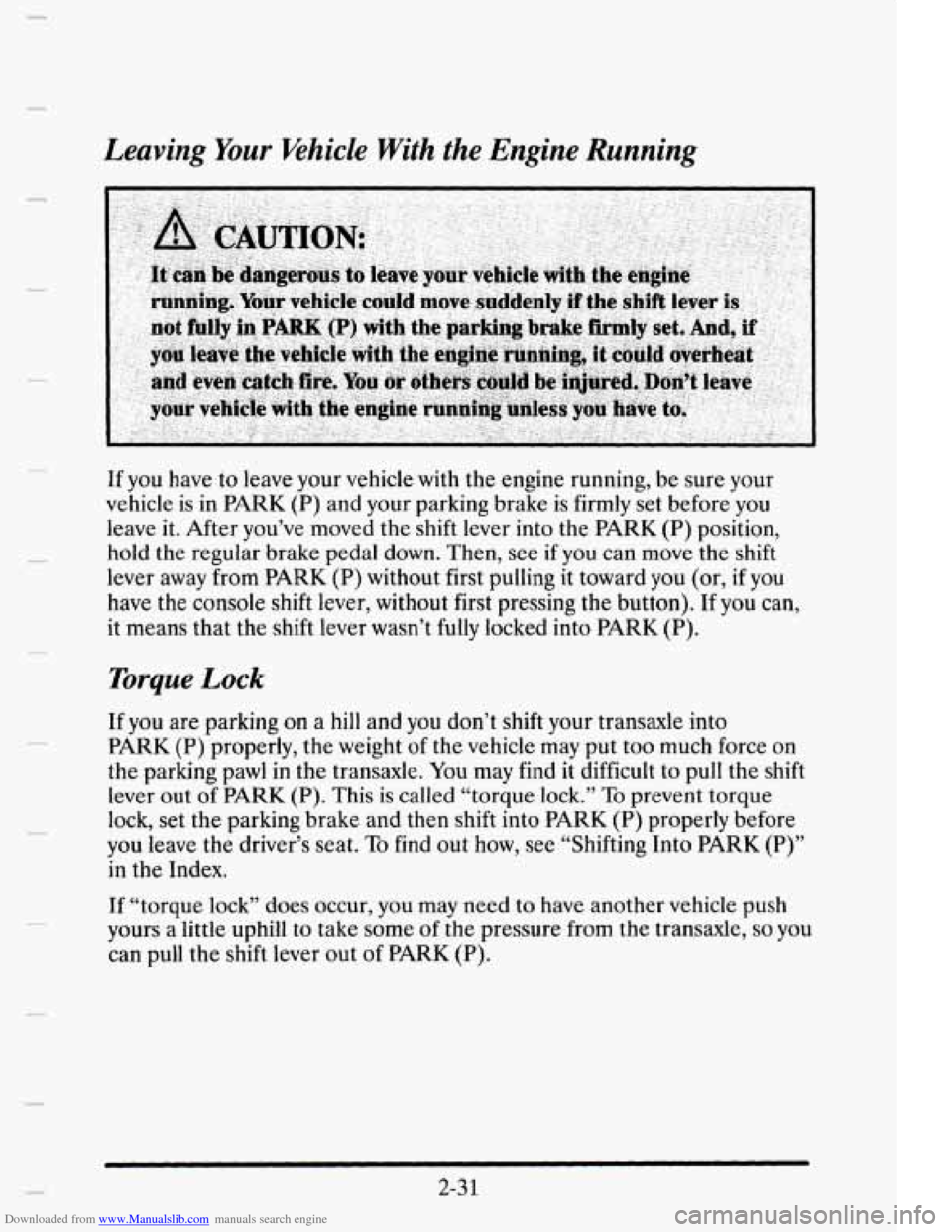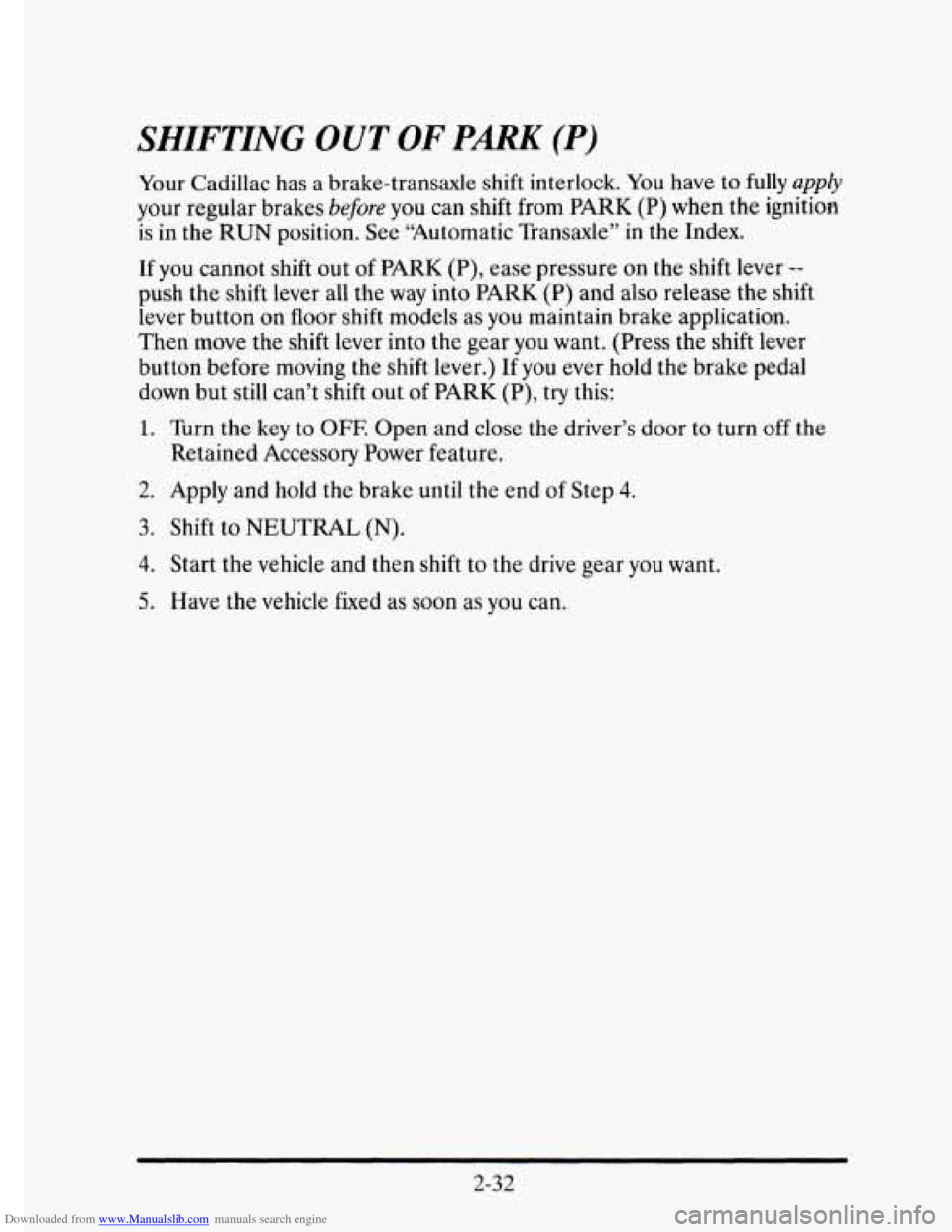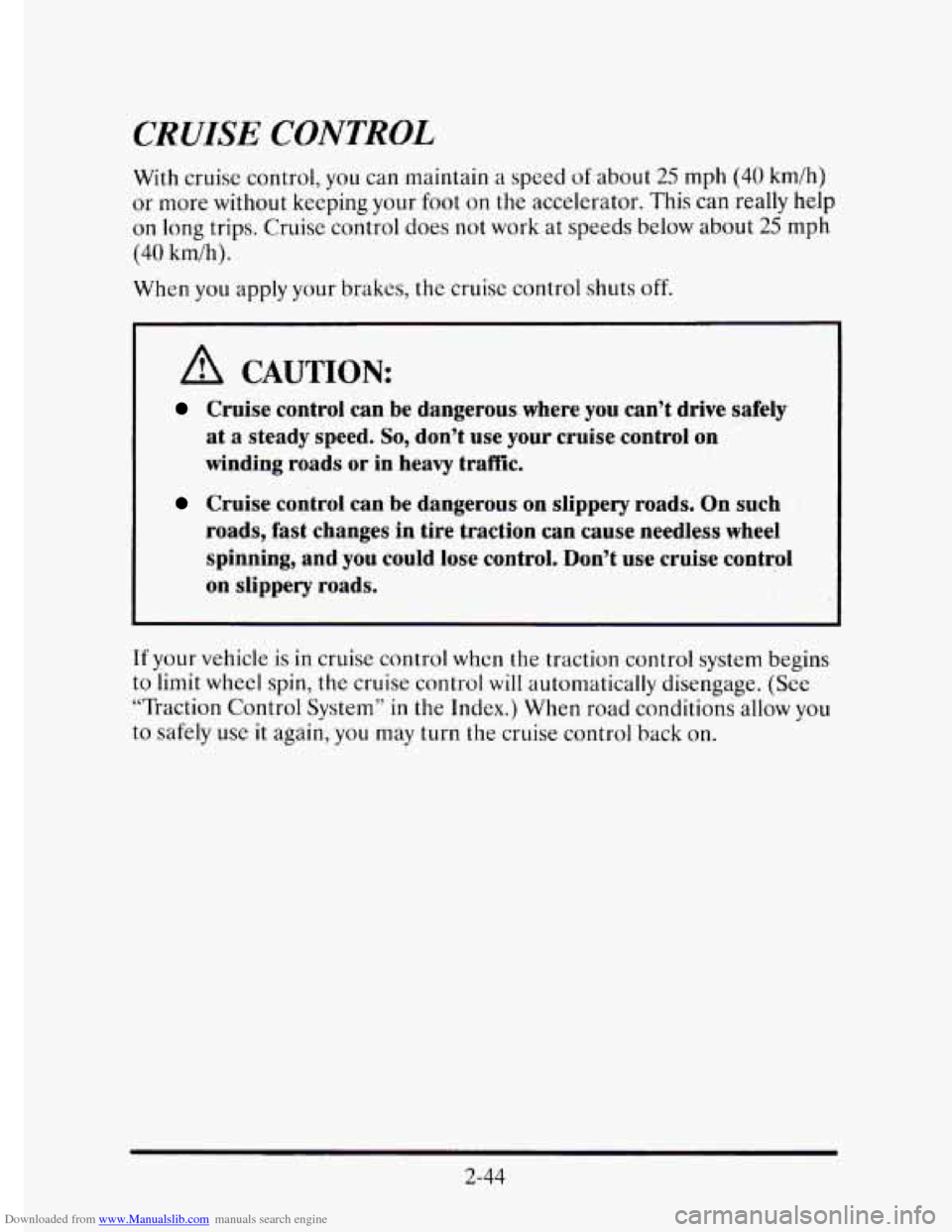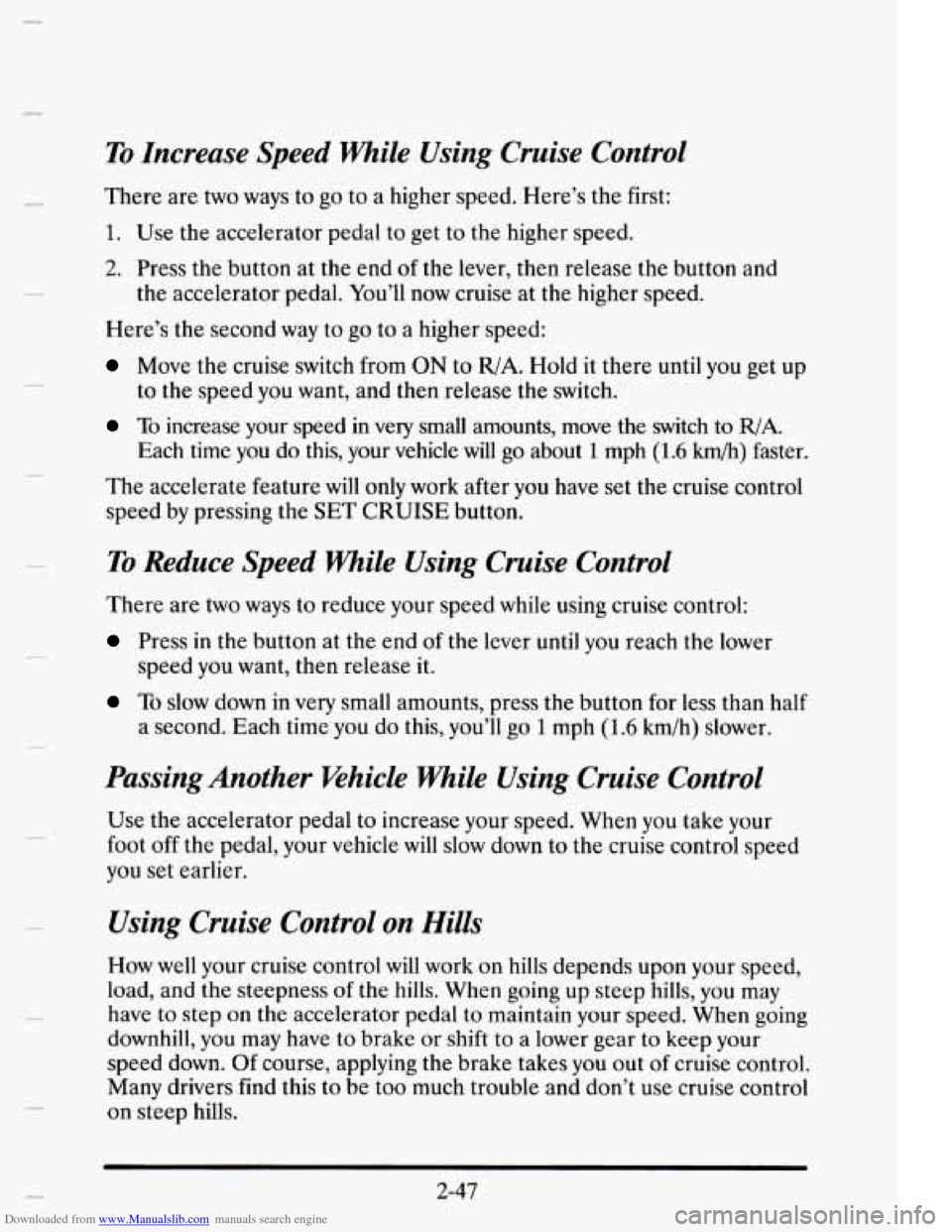Page 101 of 395
Downloaded from www.Manualslib.com manuals search engine Console Shift Lever
1. Turn the ignition key to the OFF or RUN position.
2. Hold the brake pedal down with your right foot.
3. Move the shift lever into PARK (P) position like this:
Hold in the button on
the lever, and push
the lever all the way
toward the front
of
your vehicle.
A
4. Set the parking brake with your right foot still holding the brake pedal
5. Move the ignition key to LOCK.
6. Remove the key and take it with you. If you can walk away from your
down.
vehicle with the ignition key in your hand, your vehicle is
in PARK (P).
2-30
Page 102 of 395

Downloaded from www.Manualslib.com manuals search engine Leaving Your khicle With the Engine Running
If you have to leave your vehicle with the engine running, be sure your
vehicle is in
PARK (P) and your parking brake is firmly set before you
leave it. After you’ve moved the shift lever into the PARK (P) position,
hold the regular brake pedal down. Then, see
if you can move the shift
lever away from
PARK (P) without first pulling it toward you (or, if you
have the console shift lever, without first pressing the button). If you can,
it means that the shift lever wasn’t fully locked into
PARK (P).
Torque Lock
If you are parking on a hill and you don’t shift your transaxle into
PARK (P) properly, the weight of the vehicle may put too much force on
the parking pawl in the transaxle. You may find it difficult to pull the shift
lever out
of PARK (P). This is called “torque lock.” To prevent torque
lock, set the parking brake and then shift into
PARK (P) properly before
you leave the driver’s seat.
To find out how, see “Shifting Into PARK (P)”
in the Index.
If “torque lock” does occur, you may need to have another vehicle push
yours a little uphill
to take some of the pressure from the transaxle, so you
can pull the shift lever out
of PARK (P).
2-3 1
Page 103 of 395

Downloaded from www.Manualslib.com manuals search engine SHIFTING OUT OF PRRK (P)
Your Cadillac has a brake-transaxle shift interlock. You have to fully apply
your regular brakes before you can shift from PARK (P) when the ignitioa
is
in the RUN position. See “Automatic Transaxle” in the Index.
If you cannot shift out of PARK (P), ease pressure on the shift lever --
push the shift lever all the way into PARK (P) and also release the shift
lever button on
floor shift models as you maintain brake application.
Then move the shift lever into the gear you want. (Press the shift lever
button before moving the shift lever.) If you ever hold the brake pedal
down but still can’t
shift out of PARK (P), try this:
1. Turn the key to OFE Open and close the driver’s door to turn off the
2. Apply and hold the brake until the end of Step 4.
3. Shift to NEUTRAL (N).
4. Start the vehicle and then shift to the drive gear you want.
5. Have the vehicle fixed as soon as you can.
Retained
Accessory Power feature.
2-32
Page 115 of 395

Downloaded from www.Manualslib.com manuals search engine CRUISE CONTROL
With cruise control, you can maintain a speed of about 25 rnph (40 km/h)
or more without keeping your foot on the accelerator. This can really help
on long trips. Cruise control does
not work at speeds below about 25 rnph
(40 km/h).
When
you apply your brakes, the cruise control shuts off.
A CAUTION:
Cruise control can be dangerous where you can’t drive safely
at a steady speed. So, don’t use your cruise control on
winding roads or
in heavy traf‘fic.
Cruise control can be dangerous on slippery roads. On such
roads, fast changes in tire traction can cause needless wheel
spinning, and you could lose control. Don’t use cruise control
on slippery roads.
If your vehicle is in cruise control when the traction control system begins
to limit wheel spin, the cruise control will automatically disengage. (See
“Traction Control System”
in the Index.) When road conditions allow you
to safely use it again, you may turn the cruise control back on.
2-44
Page 117 of 395
Downloaded from www.Manualslib.com manuals search engine CRUISE ENGAGED
4. The digital
instrument panel
cluster has a
CRUISE
ENGAGED light
that will come on.
On the analog cluster
the
CRUISE
ENGAGED
message
~ will display for a few
~ seconds.
5. Take your foot off the accelerator pedal.
To Resume a Set Speed
Suppose you set your cruise control at a desired speed and then you apply
the brake. This,
of course, shuts off the cruise control, however, you don’t
need
to reset it. Once you’re going about 25 mph (40 km/h) or more, you
can move the cruise control switch from
ON to R/A (ResumelAccelerate)
for about half a second.
You’ll
go right back UD to your chosen speed and stay there.
2-46
J
U
0
3
Page 118 of 395

Downloaded from www.Manualslib.com manuals search engine c
To Increase Speed While Using Cruise Control
There are two ways to go to a higher speed. Here’s the first:
1. Use the accelerator pedal to get to the higher speed.
2. Press the button at the end of the lever, then release the button and
the accelerator pedal. You’ll now cruise at the higher speed.
Here’s
the second way to go to a higher speed:
Move the cruise switch from ON to R/A. Hold it there until you get up
to the speed you want, and then release the switch.
To increase your speed in very small amounts, move the switch to R/A.
Each time you do this, your vehicle will go about 1 mph (1.6 km/h) faster.
The accelerate feature
will only work after you have set the cruise control
speed by pressing the SET CRUISE button.
To Reduce Speed while Using Cruise Control
There are two ways to reduce your speed while using cruise control:
Press in the button at the end of the lever until you reach the lower
speed you want,
then release it.
To slow down in very small amounts, press the button for less than half
a second. Each time you do this, you’ll go
1 mph (1.6 km/h) slower.
Passing Another Whicle While Using Cruise Control
Use the accelerator pedal to increase your speed. When you take your
foot off the pedal,
your vehicle will slow down to the cruise control speed
you set earlier.
Using Cruise Control on Hills
How well your cruise control will work on hills depends upon your speed,
load, and
the steepness of the hills. When going up steep hills, you may
have
to step on the accelerator pedal to maintain your speed. When going
downhill, you may have to brake or shift to a lower gear
to keep your
speed down. Of course, applying the brake takes
you out of cruise control.
Many drivers find this to be too much trouble and don’t use cruise control
on steep
hills.
2-47
Page 119 of 395
Downloaded from www.Manualslib.com manuals search engine To Get Out of Cruise Control
There are two ways to turn off the cruise control:
1. Step lightly on the brake pedal; OR
2. Move the CRUISE switch to OFF. (The CRUISE light will go out.)
To Erase Speed Memory
When you turn off the cruise control or the ignition, your cruise control
set speed memory is erased.
2-48
1
Page 146 of 395
Downloaded from www.Manualslib.com manuals search engine Battery Charge Light (Canadian Only)
When you turn the key
to
RUN or START, this
light will come on
briefly, to show that
your alternator and
battery charging
systems are working.
(0) BRAKE
1)
BRAKE
If this light stays on you need service, and you should take your Cadillac
to the dealer at once.
To save your battery until you get there turn off all
accessories.
Brake System Warning Light
1 Your Cadillac’s
hydraulic brake system
is divided into two
parts.
If one part isn’t
working, the other part
can still work
and stop
you. For
good braking,
though,
you need both
parts working well.
If the warning light comes on, there could be a brake problem. Have your
brake system inspected right away.
One
of these lights should come on briefly as you start the vehicle. If it
doesn’t come on then, have it fixed so it will be ready to warn you if
there’s a problem.
2-75